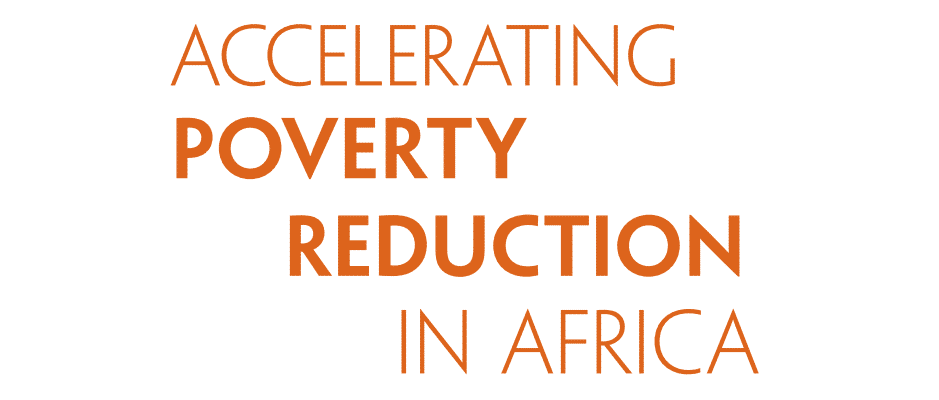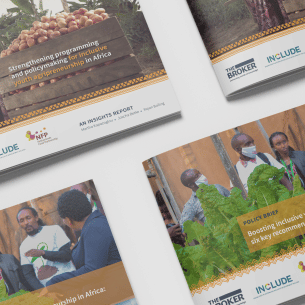
When the Sustainable Development Goals (SDGs) were announced in 2015, it was clear that success on SDG1—eradication of extreme poverty—depended on Africa’s performance. Recent forecasts from the United Nations and the World Bank suggest that Africa is not going to make it.
We should all be concerned, but what can be done? The recent World Bank study, Accelerating Poverty Reduction in Africa, offers governments and stakeholders both new suggestions as well as new takes on old recommendations, providing a clear if bumpy road map for future strategies and intervention designs. Despite its length, the report is well worth our time. I have no doubt that it will serve as a key reference volume in the coming years.
Discussion with the authors
Why has poverty in Africa stayed so stubbornly high despite record economic growth? According to the report, three main reasons: (i) less of Africa’s growth translates into poverty reduction because of high initial poverty, including low asset levels and limited access to public services, which prevent households from taking advantage of opportunities; (ii) Africa’s increasing reliance on natural resources for income growth rather than agricultural and rural development excludes the 85 percent of the poor population living in rural areas; and (iii) Africa’s high fertility and resulting high population growth mean that even high growth translates into less income per person—a point too often ignored in discussions on the sub-continent and in Washington.
In addressing these worrying trends, the report singles out four areas for particular attention: (i) reduce fertility; (ii) increase agricultural productivity, especially for food crops (an African green revolution); (iii) address risk and conflict; and (iv) increase domestic resource mobilization and focus resources on the poor. These areas are certainly key for the livelihoods and welfare of the poor, and it is great to see a report that sets a few priorities as opposed to requiring African governments to undertake a laundry list of initiatives at once. While I might have added a fifth—urban governance for poverty reduction—the focus on a few areas combined with an excellent synthesis of vast quantities of new research on what has worked in supporting economic development in Africa is both stimulating and refreshing.
Despite its importance to economic growth and poverty reduction throughout Asia and Latin America, agriculture remains a neglected sector in Africa. The report appropriately highlights this gap and calls for a focus on transforming the livelihoods of small-holder farm households. One reason for current neglect is the failure of many interventions in rural areas. The report clearly and cogently summarizes a large and recent literature on successes and failures of interventions and policies in Africa and elsewhere to argue for a renewed effort. Food crops are still the basis for the badly needed green revolution in Africa because of the large share of food that is imported; the fact that poorer farmers are more likely to produce staple crops; and, that low profit margins discourage the private sector from investing to develop the value chains in this sector the way that they do for vegetables, fruits, or sesame, for example. The report calls for public sector interventions throughout the staples value chain—in research and development, infrastructure, extension and marketing—noting that interventions that only address one constraint (e.g., input quality) often fail as other binding constraints (e.g., lack of rural roads) kick in. While arguing for an integrated approach, operating on multiple constraints throughout the value chain to improving farm livelihoods, the report admits in the chapter conclusion that this is much more difficult to execute and sustain—especially if external donors are in the driver’s seat instead of domestic agencies and institutions. Although I agree with the admission, I found the chapter conclusion less than satisfactory. Is there a middle ground, addressing fewer issues with less complexity that has lower risks yet enough rewards? Also, the report ducked the genetically modified foods (GMO) controversy, even though this technology is the best hope for African agriculture (including staple crops).
Fortunately, the chapter on “mobilizing resources for the poor” is not the same old clarion call for African governments to raise taxes as a share of GDP. Though the authors do call for tax increases, they caution that expanding/increasing the value-added tax (VAT) is regressive unless complementary steps are taken (e.g., cash transfers to households), a point often missed by other experts. Introducing direct taxes on income and land (which would hit the rich) is an important recommendation that is not made often enough, especially by economists, who love the VAT despite the regressive impact. Getting more mineral extraction revenues (transparently) into the public finance system is an old chestnut showing up in this chapter. If only we could figure out how to do this in the face of massive governance failures.
New, and very welcome, is a forceful call for reducing or eliminating subsidies on agricultural inputs (especially fertilizer) and energy. The authors cite studies that show that eliminating these subsidies and sending the money directly to poor households would easily finance a basic income guarantee for poor households¹. Since the World Bank has, in the past, supported fertilizer subsidies in agricultural projects in Africa, this new position is certainly welcome. The report gives short shrift, however, to the difficulty of improving the efficiency of spending in sectors which should be pro-poor, such as health, education, and water, sanitation, and hygiene. The last page notes that “[h]ow best to improve efficiency in spending remains an exigent space for further exploration and learning.” Indeed.
The report’s clear and unambiguous presentation of the negative effects of high population growth on poverty reduction efforts is an important addition to the discussion as this issue has been mostly absent from poverty reduction discussions. No country has successfully sustained economic growth and reduced poverty at the average fertility level of sub-Saharan Africa². High fertility forces public and private expenditures on human capital development to focus on quantity rather than quality; it reduces public and private savings owing to high dependency ratios; and complicates efforts to improve livelihoods through rapid labor force growth. It is associated with low levels of female empowerment, in part because of the association with child marriage. Several authors (cited in the report) have argued that Africa’s fertility rate will not fall on its own. I agree, and there is no doubt that a focused and targeted effort is needed to address the issue, including increasing supply and demand for contraception, reducing child marriage, as well as increasing female education. African countries can do this even at very low incomes, as both Ethiopia and Rwanda have shown.
A few quibbles.
The report mostly ignores the reasons why the policies and programs African countries implement are not pro-poor. One serious omission is how monopolistic arrangements among the economic elite—for example, high transportation costs caused by lack of competition in the trucking sector, or high fertilizer prices caused by a few authorized dealers who keep prices high, and benefit a lot from subsidy programs³. In small countries and underdeveloped markets, monopolistic arrangements are more common as competition is hard to achieve. Trade could possibly help, but this would mean removing the trade barriers that cause intra-African trade to be among the costliest in the world⁴. Another omission is a discussion of why African governments have neglected agriculture, especially staple foods. Yes, this sector is hard, but prejudice among urban elites against investing in small-holder agriculture unfortunately seems to persist and does not help generate the breakthroughs needed.
The report’s special section on gender does discusses the usual intermediate causes and outcomes associated with women’s inequality (lower school enrollment for girls, high maternal mortality and the disproportionate burden of HIV/AIDS, the burden of providing domestic services, limited legal rights such as owning or inheriting property), but the fundamental cause of the inequality—a specific view about the implications of women’s childbearing role on responsibilities and acceptable behavior in economic, social, political, and private space—is not addressed. While gender norms differ across the continent, are often less binding for richer women than poorer, and certainly change over time, their importance as the underlying cause of gender inequality deserves mention.
Finally, while many argue the Africa’s macroeconomic problems are mostly under control (e.g., years of low-ish inflation and flexible exchange rate regimes, in contrast to the 1980s and 1990s), other observers expect that high levels of external and internal debt will become unsustainable if the world economy experiences a recession, even a mild one. Africa’s poor suffered a lot during the last African debt crisis. Can such negative impacts be averted this time? Maybe that will be the next report.
Readable, technocratic, and fact-filled, this report shows the strength of the World Bank as an intellectual leader in economic development thinking. The length, at almost 300 pages, and the five years spent in preparation also show the Bank’s weakness—over-thinking, over-programming, over-reviewing, and over-doing. If African thought leaders and policymakers can find a way to absorb all the facts and analysis in digestible bites, the report should have an impact on development thinking in Africa.
1. Most of these studies abstract from the costs of administering and targeting cash transfers, so the results in practice if such an approach were followed are likely to be less robust. Nonetheless, the point about regressive subsidies remains important.
2. An exception could be the Gulf States, owing to the dominance of oil earnings in the economy.
3. One justification that World Bank economists in the agricultural sector offered for supporting the fertilizer subsidies in Africa was fertilizer’s high cost relative to incomes.
4. See Porteous, Obie (2019). “High Trade Costs and Their Consequences: an estimated dynamic model of African Agriculture Storage and Trade”, American Economic Journal: Applied Economics, 11(4): 327-366 for an estimation of the welfare costs in the food market of high trade costs. This issue should clearly be discussed in the context of an agricultural strategy focused on staple foods.






